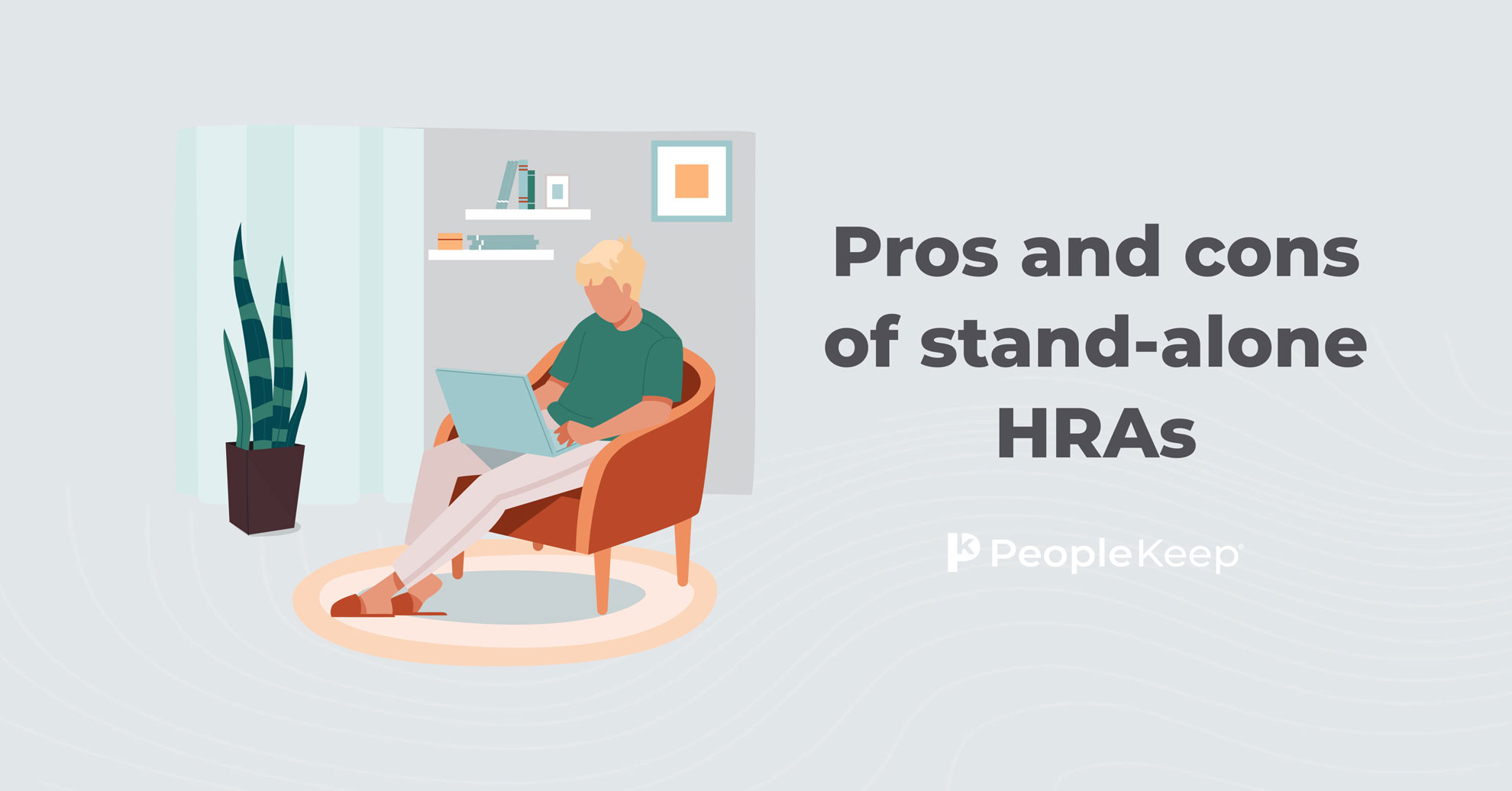The least and most expensive states for group health insurance
By Elizabeth Walker on April 18, 2025 at 8:00 AM
Offering your employees a health benefit is one of the best ways to attract and retain top talent, boost morale, and increase productivity. But for many employers, rising healthcare costs make traditional group health insurance difficult to afford. The average cost can vary greatly depending on the state where your business is located.
Understanding how location impacts healthcare costs can help you decide if you want to enroll in a group policy or provide an alternative health benefit at your company.
The article below will highlight the least and most expensive states for group health insurance so you can make the right health benefit decision for your employees.
In this blog post, you’ll learn:
- How group health insurance costs vary significantly by state.
- What group health insurance is, how it works, and what factors influence premium costs.
- How health reimbursement arrangements (HRAs) can offer a flexible and budget-friendly alternative to traditional group health plans.
What is group health insurance?
Group health insurance, or employer-sponsored health insurance, is a type of plan employers offer their employees. Group plans are often fully-insured, which involves buying a plan from a carrier. Employers can also establish self-funded group plans. With these plans, employers directly cover the cost of employees’ medical claims. For comparison purposes, we’re focusing on fully-insured plans.
Fully-insured group plans differ from individual health policies, which individual consumers buy on a private or public exchange, like the Health Insurance Marketplace, regardless of employment status.
About 154 million Americans have group health coverage. Many individuals call it the “traditional form” of health insurance, and most are generally familiar with how it works. Like other health policies, group plans usually have an annual deductible and an out-of-pocket maximum. The average deductible depends on the plan type and insurer. But, employees must meet cost-sharing limits before the insurer pays 100% of the cost for covered services.
Employer-sponsored plans vary by health insurance company and plan type. But there are several commonalities all plans share, such as the following:
- Group plans typically provide health coverage to participants at a reduced cost by spreading risk around the “group.”
- Enrolled employees make monthly premium payments to maintain insurance coverage, generally on a pre-tax basis via paycheck deduction.
- The employer and the employee often split the total health insurance premium.
- This type of health insurance usually has a minimum participation rate. The rate can vary by insurer and state, but it’s usually at least 70%.
Employees can choose whether to enroll in or decline the employer’s group plan. If they enroll, they can add eligible family members and dependents to the plan for an extra cost.
Insurers determine a group plan’s monthly premium using specific factors. These factors differ based on the type of group plan an employer offers.
Small group plans for companies with fewer than 50 employees are community-rated. This means insurers can use the following factors to determine premiums:
- Age
- Gender
- ZIP code
- Tobacco use
- Company size
- Actuarial value
- Industry of the employer
Due to the Affordable Care Act (ACA), health insurers can’t use an employee’s medical status, pre-existing conditions, or sex to determine annual premium rates for small group plans.
Large group plans are different. These plans are experience-rated.
This allows insurers to consider more factors in determining premiums, such as the following:
- Age
- Gender
- Location
- Company size
- Industry of the employer
- A group’s previous claims history
The experience-rated nature of large group plans can drive up premium costs for groups with high benefits utilization.
While group health insurance may work for many employers, it can be too rigid, time-consuming, and costly for many. This is especially true if you’re a small business owner who operates or employs workers in states with more expensive medical care.
Affordable health coverage is hard to find, even with the wide range of health insurance companies available. To better understand health insurance costs, the sections below will walk you through the average rate of group and individual plans in the least and most expensive states in the United States for group coverage.
The top ten least expensive states for group health insurance
The following chart outlines the ten states with the lowest average monthly premium costs for group health coverage, with the most recent data from 2023. We also compare the average monthly cost for individual health insurance in 2023.
|
State |
The average monthly cost of group health insurance*1 |
The average monthly cost of individual health insurance**2 |
|
Mississippi |
$603 |
$461 |
|
Arkansas |
$614 |
$416 |
|
Idaho |
$617 |
$420 |
|
Oklahoma |
$618 |
$510 |
|
South Carolina |
$619 |
$496 |
|
Kansas |
$631 |
$471 |
|
Delaware |
$636 |
$549 |
|
Alabama |
$637 |
$567 |
|
Tennessee |
$638 |
$473 |
|
Hawaii |
$644 |
$469 |
*Average group plan premium rates shown are for one employee with single coverage and include employer and employee contributions.
**Average individual premium rates shown are for a 40-year-old nonsmoker on a silver benchmark plan. This is the second-lowest-cost silver plan available.
The top ten most expensive states for group health insurance
The following chart outlines the ten states with the most expensive monthly premiums for group health insurance, with the most recent data from 2023. We also compare the average monthly cost for individual health coverage in 2023.
|
State |
The average monthly cost of group health insurance*1 |
The average monthly cost of individual health insurance**2 |
|
New Jersey |
$805 |
$441 |
|
Massachusetts |
$793 |
$417 |
|
New York |
$764 |
$627 |
|
Alaska |
$758 |
$762 |
|
Maine |
$741 |
$457 |
|
Wyoming |
$737 |
$802 |
|
Connecticut |
$729 |
$627 |
|
District of Columbia |
$728 |
$428 |
|
New Hampshire |
$723 |
$323 |
|
West Virginia |
$722 |
$824 |
*Average group plan premium rates shown are for one employee with single coverage and include employer and employee contributions.
**Average individual premium rates shown are for a 40-year-old nonsmoker on a silver benchmark plan.
How an HRA can help you control your health benefits budget
Health insurance costs continue to rise. According to KFF, employer-sponsored health insurance premiums for family coverage have increased by 24% since 2019 and by 52% since 20143. Because of this, some employers seek more affordable coverage options to meet their employees’ healthcare needs. Luckily, an HRA can help your employees pay for medical care without busting your budget.
An HRA is a formal, employer-funded health benefit that allows you to reimburse employees tax-free for qualified out-of-pocket costs and sometimes individual plan premiums.
HRAs don’t have minimum participation or contribution requirements, making them more flexible than group policies. You can choose a monthly allowance amount that works best for your budget. Then, you reimburse your employees up to that allowance once they prove they bought an eligible medical care item or healthcare service.
Two common types of HRAs are stand-alone HRAs and integrated HRAs. Below, we’ll briefly discuss each healthcare option to help you understand how they can work for your business.
Stand-alone HRAs
Stand-alone HRAs are an affordable alternative to group health insurance. They are a great solution if your company is in a state with more expensive employer-sponsored plans or if you’re facing steep rate hikes. With stand-alone HRAs, employees choose their preferred individual health insurance policy. Then, you reimburse them for the plan’s monthly premium and other eligible out-of-pocket costs.
This means your employees can choose the health insurance company, policy, and provider networks that work best for them. And because HRAs have no annual rate hikes, you have more control over your healthcare spending and can optimize your savings.
The following are the two most popular stand-alone HRAs:
- Individual coverage HRA (ICHRA): The ICHRA is for businesses of any size and has no minimum or maximum contribution limits. You can set different employee classes to vary eligibility and allowances. You can also differ allowances by age or family status.
- Employees must have a qualified individual health plan to participate in the ICHRA. But depending on affordability, they can choose to opt in or out of the benefit.
- Qualified small employer HRA (QSEHRA): A QSEHRA is for small businesses with fewer than 50 full-time equivalent employees (FTEs). The federal government sets annual maximum limits, but no minimum limits exist. Full-time employees are eligible for the benefit. You can also offer the QSEHRA to part-time workers as long as they receive the same allowance as full-time employees.
- Your staff must have a health insurance plan with minimum essential coverage (MEC) to use the benefit.
Integrated HRAs
If you're in a state where group health plans are budget-friendly, you may want to buy an employer-provided insurance coverage or keep your existing group policy. In that case, you can build a more robust health benefit by supplementing your employer-sponsored plan with an integrated HRA.
An integrated HRA, or group coverage HRA (GCHRA), coordinates with group health insurance. Like the ICHRA, it’s for companies of all sizes, industries, and budgets. With a GCHRA, you can reimburse your employees for various out-of-pocket expenses.
Here are a few key features of GCHRAs:
- Integrated HRAs have no contribution limits and allow allowance customization using seven employee classes. This personalization helps you control healthcare costs.
- Only employees enrolled in an employer’s group health insurance policy can participate in an integrated HRA—they can’t have individual coverage only.
- Employers can use their GCHRA to reimburse employees for qualified medical expenses. Eligible medical costs include deductibles, coinsurance, copayments, and other out-of-pocket costs. But, the law prohibits you from reimbursing employees for group plan premiums.
- An integrated HRA can work with any group health insurance policy. But, many employers choose a high deductible health plan (HDHP) to use with their integrated HRA. With this type of plan, you can better save on annual premium costs.
Even if you live in a state with an affordable cost of health insurance, an integrated HRA can help you control your budget while providing your employees with flexible and comprehensive healthcare.
Conclusion
Many employers offer their staff group health insurance because it’s a familiar coverage option. But, depending on your location, traditional group coverage may not give you the best bang for your buck. That’s why understanding the factors that affect annual premium rates is key when choosing a health benefit for your employees.
If you live in a state with costly group plans or simply want to offer your staff a more flexible health benefit, consider an HRA from PeopleKeep by Remodel Health. Our HRA specialists can set you up with the perfect health benefit for your company. Book a call with our team today, and we’ll get you started designing your benefit!
This article was originally published on February 8, 2017. It was last updated on April 18, 2025.
Check out more resources
See these related articles

Common types of health insurance plans
Learn the pros and cons of the most common types of health insurance plans, such as PPOs, HMOs, HSA-qualified plans, indemnity plans, and alternatives.

Pros and cons of stand-alone HRAs
Stand-alone HRAs can offer flexibility and control over healthcare expenses, allowing employers to customize plans to meet their employees' needs.

What is coinsurance?
Understanding coinsurance is essential for managing your healthcare expenses. Learn everything you need to know about coinsurance in this helpful article.



